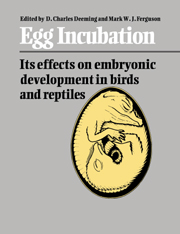Book contents
- Frontmatter
- Contents
- Preface
- Contributors
- 1 Maternal diet, maternal proteins and egg quality
- 2 Comparative composition and utilisation of yolk lipid by embryonic birds and reptiles
- 3 Oviductal proteins and their influence on embryonic development in birds and reptiles
- 4 Fluxes during embryogenesis
- 5 Eggshell structure and formation in eggs of oviparous reptiles
- 6 Shell structure and formation in avian eggs
- 7 Physical characteristics of reptilian eggs and a comparison with avian eggs
- 8 Egg-shape in birds
- 9 The thermal energetics of incubated bird eggs
- 10 Physiological effects of incubation temperature on embryonic development in reptiles and birds
- 11 Cold torpor, diapause, delayed hatching and aestivation in reptiles and birds
- 12 Physical factors affecting the water exchange of buried reptile eggs
- 13 Physiological and ecological importance of water to embryos of oviparous reptiles
- 14 Roles of water in avian eggs
- 15 Water economy and solute regulation of reptilian and avian embryos
- 16 The avian eggshell as a mediating barrier: respiratory gas fluxes and pressures during development
- 17 Gas exchange across reptilian eggshells
- 18 Metabolism and energetics of reptilian and avian embryos
- 19 Reasons for the dichotomy in egg turning in birds and reptiles
- 20 A comparison of reptilian eggs with those of megapode birds
- 21 Why birds lay eggs
- 22 Influences of incubation requirements on the evolution of viviparity
- 23 Overview of early stages of avian and reptilian development
- 24 Ions and ion regulating mechanisms in the developing fowl embryo
- 25 Electrochemical processes during embryonic development
- 26 Methods for shell-less and semi-shell-less culture of avian and reptilian embryos
- 27 Experimental studies on cultured, shell-less fowl embryos: calcium transport, skeletal development, and cardio-vascular functions
- Index
11 - Cold torpor, diapause, delayed hatching and aestivation in reptiles and birds
Published online by Cambridge University Press: 16 November 2009
- Frontmatter
- Contents
- Preface
- Contributors
- 1 Maternal diet, maternal proteins and egg quality
- 2 Comparative composition and utilisation of yolk lipid by embryonic birds and reptiles
- 3 Oviductal proteins and their influence on embryonic development in birds and reptiles
- 4 Fluxes during embryogenesis
- 5 Eggshell structure and formation in eggs of oviparous reptiles
- 6 Shell structure and formation in avian eggs
- 7 Physical characteristics of reptilian eggs and a comparison with avian eggs
- 8 Egg-shape in birds
- 9 The thermal energetics of incubated bird eggs
- 10 Physiological effects of incubation temperature on embryonic development in reptiles and birds
- 11 Cold torpor, diapause, delayed hatching and aestivation in reptiles and birds
- 12 Physical factors affecting the water exchange of buried reptile eggs
- 13 Physiological and ecological importance of water to embryos of oviparous reptiles
- 14 Roles of water in avian eggs
- 15 Water economy and solute regulation of reptilian and avian embryos
- 16 The avian eggshell as a mediating barrier: respiratory gas fluxes and pressures during development
- 17 Gas exchange across reptilian eggshells
- 18 Metabolism and energetics of reptilian and avian embryos
- 19 Reasons for the dichotomy in egg turning in birds and reptiles
- 20 A comparison of reptilian eggs with those of megapode birds
- 21 Why birds lay eggs
- 22 Influences of incubation requirements on the evolution of viviparity
- 23 Overview of early stages of avian and reptilian development
- 24 Ions and ion regulating mechanisms in the developing fowl embryo
- 25 Electrochemical processes during embryonic development
- 26 Methods for shell-less and semi-shell-less culture of avian and reptilian embryos
- 27 Experimental studies on cultured, shell-less fowl embryos: calcium transport, skeletal development, and cardio-vascular functions
- Index
Summary
Introduction
This chapter considers temporary suspension of active development within the oviposited eggs of reptiles and birds. These various processes appear to be ‘natural’ and adaptive; however, much of the study about them has occurred in the laboratory.
As presently known, all oviposited reptilian and avian embryos have advanced in development to blastulae or beyond (Bellairs, Chapter 23). In many, perhaps all, turtles embryonic development becomes arrested as a late gastrula within the oviducts and resumes normally only after oviposition (Ewert, 1985). In lizards, developmental arrest may occur in the oviducts in a few cases, e.g. Sceloporus jarrovi, which is ovoviviparous (Goldberg, 1971), but these must be very rare (Shine, 1983, 1985). The egg of the Tuatara (Sphenodon punctatus) is laid at an early embryonic stage, as in turtles, but whether this stage is also associated with pre-ovipositional arrest is unknown (Moffat, 1985). In snakes, crocodilians and birds, pre-ovipositional arrest is unknown and unlikely (Ferguson, 1985; Blackburn & Evans, 1986; Lance, 1987).
After oviposition, development within reptilian or avian eggs of many species can be divided into periods of active embryonic differentiation and growth and periods of relative inactivity, when as time passes there is little change. Such prolongations can be grouped as 1) cold torpor, 2) diapause, and 3) delayed hatching, which grades into aestivation in some reptiles. A previous survey of these topics (Ewert, 1985) focuses on turtles, but gives some reference to lizards and other vertebrates.
Information
- Type
- Chapter
- Information
- Egg IncubationIts Effects on Embryonic Development in Birds and Reptiles, pp. 173 - 192Publisher: Cambridge University PressPrint publication year: 1991
Accessibility standard: Unknown
Why this information is here
This section outlines the accessibility features of this content - including support for screen readers, full keyboard navigation and high-contrast display options. This may not be relevant for you.Accessibility Information
- 30
- Cited by
